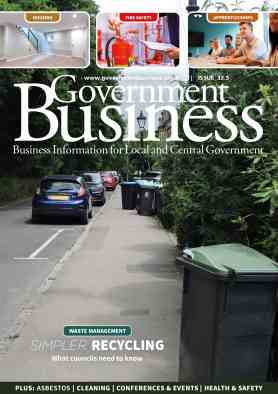Grantex is the UK’s leading supplier of specialist aggregates and producer of Premium Dried Sports Sand for High-Performance Synthetic Pitches.
Steps towards a leaner, greener printing industry
 The print and media industry is now the UK's fourth largest industrial sector. The UK print sector alone has over ten thousand companies and employs in excess of 140 thousand people. Despite the rise of other media including the internet the industry is still responsible for multi billion annual sales and an import export surplus of close to a billion pounds.
The print and media industry is now the UK's fourth largest industrial sector. The UK print sector alone has over ten thousand companies and employs in excess of 140 thousand people. Despite the rise of other media including the internet the industry is still responsible for multi billion annual sales and an import export surplus of close to a billion pounds.
Recent independent surveys continue to demonstrate print media as an effective medium for ensuring messaging is clearly communicated and most marketing and communication managers still see print as a core element in their campaigns. Due to the success of cross European campaigns many of the myths associated with the unfavourable environmental comparison between print and digital media have been dispelled.
Responsible use of print
“Two Sides” as an organisation was created in 2008 with members from the Graphic Communications Supply Chain including forestry, pulp, paper, ink, chemicals, pre-press, press, finishing publishing and printing with a common goal to promote the responsible production and use of print and paper and to dispel common environmental misconceptions by providing users with reliable information on why print and paper is an attractive practical and sustainable communication medium.
Its website www.twosides.info provides a wealth of information supporting its mission and its “Myths and Facts” section provides the data to combat so called “green wash”.
Print and paper manufacture through continual investment in changing technologies and processes has significantly reduced its environmental impact and each member within the supply chain has an excellent story to tell in terms of both material usage, and process improvements. Whilst some of these initiatives have been driven by legislation most have resulted from the industries drive towards Corporate Social Responsibility.
Wood and recovered paper are the base raw materials that provide fibre for paper making. Sustainable forestry and paper recovery systems are at the heart of paper production. Most virgin paper used in the UK is sourced from sustainable forests and the industry has an outstanding record for recycling. The life cycle of wood fibres is extended by using recovered paper in the production of new paper. In Europe collection rates have now reached 70 per cent. The industry has worked hard with collection agencies to reinforce the need for appropriate segregation to ensure maximum use is made of this important recycling material.
The EU has stipulated that by 2020 twenty percent of all energy will be from renewable sources such as wind, solar energy and bio energy. The last category is likely to include the incineration of wood and recovered paper.
The industry is canvassing to encourage a hierarchy of use to combat the diversion of wood pulp to fuel prior to printing.
Whilst the print and paper industry is an intensive user of water it is not a large consumer. The investment in modern water treatment plants by many producers means that over 90 per cent of water used is returned to the water system from where it was extracted in many cases in better condition than its original content.
Paper making is an energy intensive activity but significant progress has been made in reducing the impacts through the use of bio energy the installation of CHP plants and production efficiencies across the full production cycle.
Understanding sustainable paper
Understanding sustainable paper procurement including Forest certificates can seem daunting. The two most established endorsements are The FSC and PEFC certifications.
The Forest Stewardship Council which provides global standards for forest management encompasses a balance of environmental social and economic aspects. The well being of forest communities and eco-systems is as important as replacing trees in ensuring the future of the world’s forests. The FSC system also provides a way of tracking forest products through independently verified Chain of Custody Certification. This has to cover every stage in processing, conversion, distribution, and printing before the final product can carry the FSC label.
Forest certificate schemes
The Programme for the Endorsement of Forest Certificate Schemes is an independent non profit; non governmental organisation founded in 1999 which promotes sustainably managed forests through independent third party certifications. The PEFC provides an assurance mechanism to purchasers of wood and paper products that they are promoting the sustainable management of forests.
The newly introduced EU Timber Regulations places a set of requirements on those using imported timber based products taking away some of the voluntarism of the above schemes.
Carbon measurement has over the last decade played an increasingly important role in the reporting of environmental impacts. In 2007 the United Nations Intergovernmental Panel on Climate Change highlighted their global impacts. They identified the primary cause of climate change as being Greenhouse Gasses.
These are produced in nearly all human activities including agriculture, transport, sewage treatment, and energy generation. (There is a direct correlation between CO2 carbon fossil emissions and energy consumption.)The Kyoto treaty set targets for the reduction of greenhouse gasses.
Whilst improved energy efficiency is the fastest and cheapest way to reduce CO2, most companies within the industry are now looking to a more integrated approach to managing their environmental impacts and efficiencies and are adopting a range of environmental standards including EMAS (Eco Management and Audit scheme). This is a voluntary initiative designed to improve companies’ environmental performance. Its aim is to recognise those organisations that go beyond minimum legal compliance and continuously improve their environmental performance. In addition it is a requirement of the scheme that participating organisations regularly produce a statement that reports on their environmental performance. It is this voluntary publication of environmental information- whose accuracy has been independently checked by an environmental verifier that gives EMAS and those organisations that participate, approximately 110 in Europe so far, enhanced credibility and recognition.
ISO 14001 standard represents the core set of standards used by organisations for designing and implementing an effective environmental standard whilst the BPIF Environmental Health Check questionnaire has fifteen sections and one hundred and ten elements to direct an organisations evaluation of their environmental performance.
Five steps in waste minimisation
Each of the above approaches identify with the five steps in the successful minimisation of waste: gather available information, identify opportunities and prioritise, make initial savings, measure savings, review to identify the next focus areas.
And underpinning the steps are the principals of the Four Rs: systematically conserve resources through redesign, reduce waste, re-use materials where practical and recycle through the effective collection and separation of materials.
An integrated approach to the total supply chain of waste undoubtedly delivers improved business efficiency. Printing companies recognise these as: Cost savings from waste reduction reuse and recycling and lower disposal costs; Reduced purchasing costs from using less ink, paper, solvent, water and energy; Reduced Volatile Organic Compound emissions; Improved product quality and process control; Providing a basis to comply with regulations; Reduced insurance premiums; Improved brand image and differentiation to customers financial and investment institutions, neighbours and regulators.
Defining a carbon footprint
There is a plethora of other terminology that has emerged as climate change and other environmental drivers have gained visibility across the globe. Carbon footprint is a frequently used term that has no precise scientific definition for fossil CO2 emissions.
A commonly accepted description is “The carbon footprint is a measure of the exclusive total amount of carbon dioxide emissions that is directly and indirectly caused by an activity or is accumulated over the life stages of a product (ISA Research report 2007).
There are currently a number of models and philosophies for calculating a carbon footprint and the BPIF is currently working with a number of companies and suppliers to define a definition and process to suit the needs of the printing industry.
Often associated with carbon footprint is the term ‘Carbon Neutral’ - this is defined as no net carbon emissions across a producer’s entire life cycle either for a total process or a total product. The term carbon neutral allows a company to negate the creation of its carbon by avoiding the release of or removing from the atmosphere the same amount of carbon somewhere else. The Kyoto treaty mandates that this must be “real, verifiable and additional to what otherwise would have occurred”
Each of these initiatives plays an important role in developing strategies that not only address the role of products in effectively taking messages to the aimed recipients but also do so in a ‘Corporately Socially Responsible’ way.
The European Printing and Paper Industry have an excellent track record. Visit the Two Sides website for more details with a whole range of data to substantiate the value of the industry.
Further information
www.britishprint.com
Company Focus
Event Diary
Join us for the landmark 10th Anniversary of the London Build Expo, the UK’s largest and most influential construction and design show.
Retail Supply Chain & Logistics Expo returns to Excel London across 12-13 November, once again bringing together the world of logistics, supply chain, eCommerce and retail innovation for two dynamic days of opportunity.
Every sport, from grassroots football to world-class tournaments, depends on one constant: high-quality playing surfaces and well-maintained green spaces.
Supplier Profiles
Bauder Accepts Keys to its New UK Distribution Centre at Gateway 14
Bauder marked a major milestone in its UK expansion with the official handover of a brand
Words of World: Bridging language barriers with excellence
At Words of World, we specialise in professional translation and interpreting, d
Latest Features
The British Institute of Cleaning Science (BICSc) and the Cleaning & Support Services Association (CSSA) have successfully completed a groundbreaking project aimed at exploring the future of cleaning. This collaboration marks a significant milestone in the cleaning industry, reflecting a shared commitment to embracing innovation with confidence.
The Crown Commercial Service’s (CCS) new framework on Language Services (RM6302), dealing with translation, transcription and interpreting, is live, running from 7th May 2025 to 6th May 2028.










